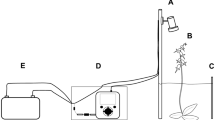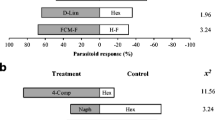Abstract
Predation is probably the most important male mortality factor in insect species with courtship displays that render males performing them conspicuous targets of predators. Sexually active Mediterranean fruit fly males, Ceratitis capitata (Wied.), aggregate in leks, where they participate in agonistic encounters and engage in visual, acoustic and pheromone-calling displays to attract receptive females. The objective of this study was to assess: a) whether sexually displaying C. capitata males in leks inside host and non-host foliage are subject to predation by the most prominent predators yellow-jacket wasps, Vespula germanica (F.), and if so, b) whether olfactory, visual or auditive stimuli are used by foraging wasps in locating male C. capitata prey. Studies were carried out in a citrus orchard and surroundings on the island of Chios, Greece. Observations were conducted using perforated containers hung within mulberry, fig or citrus foliage. Living C. capitata flies of different sex and either mature or immature were placed inside. Our results show that the yellowjacket wasps have learned to associate the presence of sexually active medfly males aggregated in leks with their prey's pheromone (kairomone). Foraging wasps, flying through the crowns of host trees, responded to the odour source of C. capitata male pheromone by approaching from downwind. Even inside dense citrus tree foliage, wasps keyed in on aggregations of pheromone-calling males using olfactory stimuli. Stimuli of visual and acoustic male signalling were only used at close range, after having followed the pheromone plume close to its source. Visual cues played a greater role in directing wasp foraging under more open and exposed host foliage conditions. Odour-based foraging of wasps inside host foliage in the mid-morning hours, when medfly male lekking activities peak, shifted gradually to a more visual-based host fruit patrolling in the afternoons to capture ovipositing and feeding medfly females. On ripe fruit, particularly fig, V. germanica visual prey hunting also included the capture of feeding medfly males, other feeding Diptera, as well as medfly larvae extracted from wasp-made perforations in the fruit.
Similar content being viewed by others
References
Akre RD, Greene A, MacDonald JF, Landolt PJ, Davis HG (1981) Yellowjackets of America north of Mexico. U.S. Department of Agriculture, Agricultural Handbook no. 552
Aluja M, Hendrichs J, Cabrera M (1983) Behaviour and interactions between Anastrepha ludens (L) and A. obliqua (M) on a field caged mango tree. I. Lekking behaviour and male territoriality. In: Cavalloro R. (ed) Fruit flies of economic importance. Balkema, Rotterdam, pp 122–133
Arakaki N, Kuba H, Soemori H (1984) Mating behaviour of the Oriental fruit fly, Dacus dorsalis Hendel (Diptera: Tephritidae). Appl Entomol Zool 19: 42–51
Bernays EA (1989) Host range in phytophagous insects: the potential role of generalist predators. Ecol Entomol 3: 299–311
Blackith RE (1957) The analysis of social facilitation at the nest entrance of some Hymenoptera. Physiol Comp Oecol 4: 388–402
Burk T (1982) Evolutionary significance of predation on sexually signalling males. Fla Entomol 65: 90–04
Duncan C (1939) A contribution to the biology of North American vespinae wasps. Stanford Univ Publ Biol Sci 8: 1–272
Evans HE, West-Eberhard MJ (1970) The wasps University of Michigan Press, Ann Arbor
Feron M (1962) L'instinct de reproduction chez la mouche mediteraneean des fruits Ceratitis capitata Wied. (Dip. Trypetidae). Comportement sexuel. Comportement de ponte. Rev Pathol Veg Entomol Agric Fr 41: 1–129
Franz G, Gencheva E, Kerremans P (1994) Improved stability of genetic sex separation strains for Mediterranean fruit fly, Ceratitis capitata. Genome 37: 72–82
Free JB (1970) The behavior of wasps (Vespula germanica L. and V. vulgaris L.) when foraging. Insectes Soc 17: 11–20
Gollands BE (1983) Aspects of foraging by the yellowjacket, Vespula germanica (Fabricius) (Hymenoptera: Vespidae). Masters Dissertation, Cornell University, Ithaca
Greene A (1991) Dolichovespula and Vespula. In: Ross KG, Matthews WR (eds) The social biology of wasps. Cornell University Press, Ithaca, pp 263–305
Greene E, Orsak LJ, Whitman DW (1987) A tephritid fruit fly mimics the territorial displays of its jumping spider predators. Science 236: 310–312
Harris RJ (1991) Diet of the wasps Vespula vulgaris and V. germanica in honeydew beech forest of the South Island, New Zealand. NZ J Zool 18: 159–169
Heinrich B (1984) Strategies of thermoregulation and foraging in 2 vespid wasps Dolichovespula maculata and Vespula vulgaris. J Comp Physiol [B] Biochem Syst Environ Physiol 154: 175–180
Hendrichs J, Hendrichs MA (1990) Mediterranean fruit fly (Diptera: Tephritidae) in nature: location and diel pattern of feeding and other activities on fruiting and nonfruiting hosts and nonhosts. Ann Entomol Soc Am 83: 632–641
Hendrichs J, Katsoyannos BI, Papaj DR, Prokopy RJ (1991) Sex differences in movement between natural feeding and mating sites and trade-offs between food consumption, mating success and predator evasion in Mediterranean fruit flies (Diptera: Tephritidae). Oecologia 86: 223–231
Hendrichs J, Wornoayporn V, Katsoyannos BI, Gaggl K (1993) First field assessment of the dispersal and survival of mass reared sterile Mediterranean fruit fly males of an embryonal, temperature sensitive genetic sexing strain. In: Management of insect Pests: Nuclear and Related Molecular and Genetic Techniques, IAEA, Vienna, Austria, pp 453–462
Iwata K (1976) Evolution of instinct. Comparative ethology of hymenoptera. Amerind, New Delhi
Leyva JL, Browning HW, Gilstrap FE (1991) Effect of host fruit species, size, and color on parasitization of Anastrepha ludens (Diptera: Tephritidae) by Diachasmimorpha longicaudata (Hymenoptera: Braconidae). EnvironEntomol 20: 1469–1474
Malavasi A, Morgante JS, Prokopy RJ (1983) Distribution and activities of Anastrepha fraterculus (Diptera: Tephritidae) flies on host and nonhost trees. Ann Entomol Soc Am 76: 286–292
Maschwitz U, Beier W, Dietrich T, Keidel W (1974) Fütterverständigung bei Wespen der Gattung Paravespuld. Naturwissenschaften 61: 506
Matsuura M, Yamane S (1990) The biology of vespine wasps. Springer, Berlin Heidelberg New York
Matthews RW, Matthews JR (1988) Insect behaviour. Krieger, Malabar, Fla
Messing RH, Jang EB (1992) Response of the fruit fly parasitoid Diachasmimorpha longicaudata (Hymenoptera: Braconidae) to host-fruit stimuli. Environ Entomol 21: 1189–1195
Morris D (1965) The function and causation of courtship ceremonies. In: Grasse P (ed) L Instinct dans le comportement des animaux et de l'homme. Masson, Paris, pp 261–287
Papaj DR, Lewis AC (1993) Insect learning ecological and evolutionary perspectives, Chapman and Hall, New York
Papaj DR, Prokopy RJ (1989) Ecological and evolutionary aspects of learning in phytophagous insects. Annu Rev Entomol 34: 315–50
Papaj DR, Katsoyannos BI, Hendrichs J (1989) Use of fruit wounds in oviposition by Mediterranean fruit flies. Entomol Exp Appl 53: 203–209
Parrish MD, Fowler HG (1983) Contrasting foraging related behaviours in two sympatric wasps (Vespula maculifrons and V. germanica). Ecol Entomol 8: 185–190
Prokopy RJ, Hendrichs J (1979) Mating behaviour of Ceratitis capitata on a field-caged host tree. Ann Entomol Soc Am 72: 642–648
Raveret-Richter M (1988) Prey hunting and interactions among social wasp (Hymenoptera: Vespidae) foragers and responses of caterpillars to hunting wasps. PhD Thesis, Cornell University, Ithica, NY
Raveret-Richter M, Jeanne RL (1985) Predatory behaviour of Polybia sericea (Olivier), a tropical social wasp (Hymenoptera: Vespidae). Behav Ecol Sociobiol 16: 165–170
Raveret-Richter M, Jeanne RL (1991) Hunting behaviour, prey capture and ant avoidance in the tropical social wasp Polybia sericea (Hymenoptera: Vespidae). Insectes Soc 38: 139–147
Shelly TE, Kaneshiro KY (1991) Lek behaviour of the oriental fruit fly, Dacus dorsalis, in Hawaii (Diptera: Tephritidae). J Insect Behav 4: 235–241.
Sivinski J (1991) The influence of host fruit morphology on parasitization rates in the Caribbean fruit fly, Anastrepha suspensa. Entomophaga 36: 447–454
Suzuki Y, Koyama J (1980) Temporal aspects of mating behaviour of the melon fly, Dacus cucurbitae Coquillet (Diptera: Tephritidae): a comparison between laboratory and wild strains. Appl Entomol Zool 15: 215–224
Tan KH (1993) Ecohormones for the management of fruit fly pests. Understanding plant-fruit fly-predator interrelationships. In: Management of insect pests: nuclear and related molecular and genetic techniques. IAEA, Vienna, pp 495–503
Vinson SB (1976) Host selection by insect parasitoids. Annu Rev Entomol 21: 109–133
Author information
Authors and Affiliations
Rights and permissions
About this article
Cite this article
Hendrichs, J., Katsoyannos, B.I., Wornoayporn, V. et al. Odour-mediated foraging by yellowjacket wasps (Hymenoptera: Vespidae): predation on leks of pheromone-calling Mediterranean fruit fly males (Diptera: Tephritidae). Oecologia 99, 88–94 (1994). https://doi.org/10.1007/BF00317087
Received:
Accepted:
Issue Date:
DOI: https://doi.org/10.1007/BF00317087




